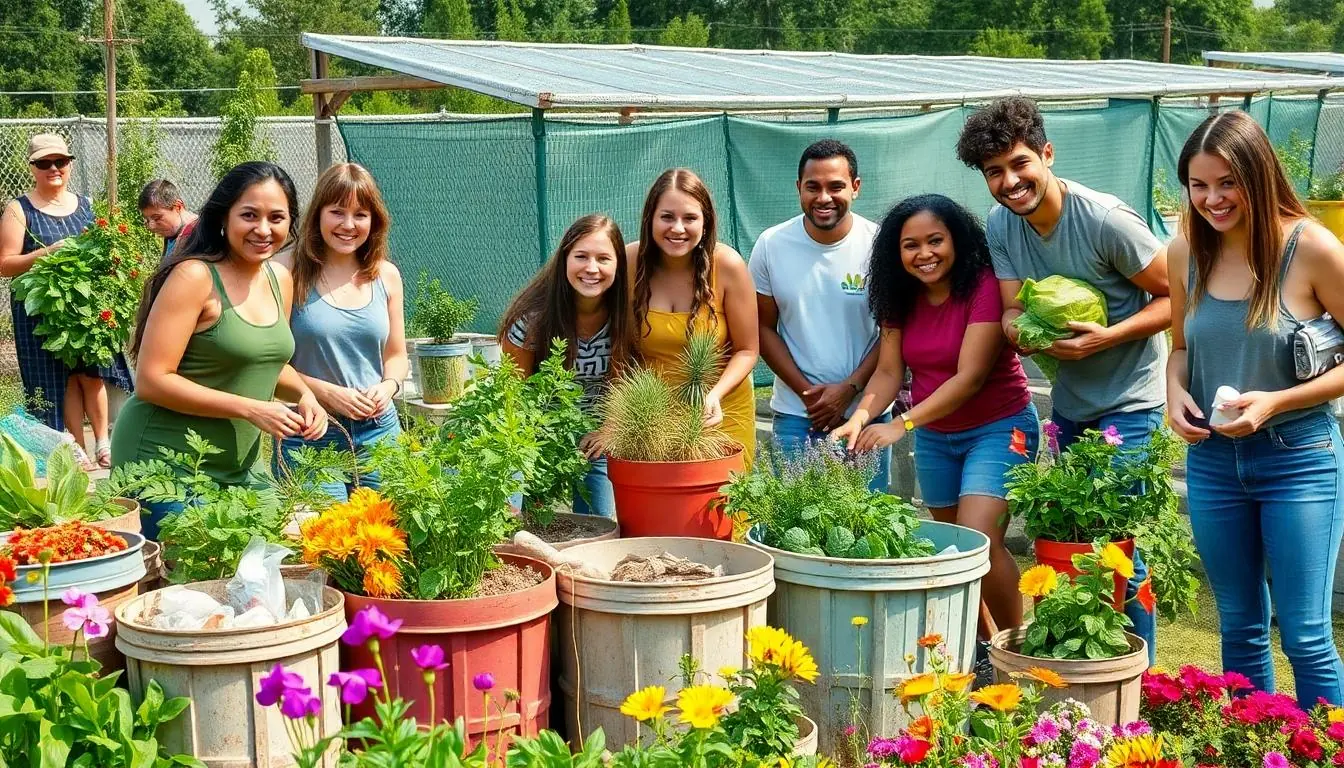Table of Contents
ToggleIn a world where plastic seems to multiply faster than rabbits, the quest for sustainable living has never been more urgent—or more entertaining. Imagine a lifestyle where you can save the planet while still enjoying your morning coffee and binge-watching your favorite shows. Sounds like a dream, right? Well, it’s time to wake up and smell the organic coffee!
This sustainable living guide is your ticket to a greener lifestyle without sacrificing comfort or fun. From eco-friendly swaps that won’t break the bank to quirky tips that’ll make your friends wonder if you’ve joined a secret club, this guide has it all. So grab your reusable tote, and let’s dive into the world of sustainable living—where saving the Earth is as easy as pie (and just as delicious).
Understanding Sustainable Living
Sustainable living involves making choices that reduce environmental impact. Those choices often prioritize conservation and resource efficiency.
What Is Sustainable Living?
Sustainable living means adopting practices that conserve natural resources and improve environmental quality. It encompasses various aspects, like reducing waste, conserving energy, and supporting local economies. Individuals can integrate eco-friendly habits into daily routines, such as using reusable bags, choosing plant-based foods, or reducing water consumption. By making these adjustments, he or she contributes to a healthier planet while enjoying a fulfilling lifestyle.
Benefits of Sustainable Living
Adopting sustainable living practices yields numerous benefits. Health improvement stands out as one of the key factors; consuming organic foods can enhance nutrition and reduce exposure to harmful chemicals. Financial savings are another significant advantage, as energy-efficient appliances lower utility bills. Communities also benefit through stronger local economies, fostering relationships between consumers and producers. Environmental enhancements, such as cleaner air and water, result from sustainable actions, promoting overall well-being. Sustainable living builds resilience against climate challenges, ensuring a better future for generations to come.
Key Principles of a Sustainable Living Guide

Sustainable living involves key practices that reduce environmental impact. Integrating these principles improves both personal wellbeing and the planet’s health.
Reducing Waste
Reducing waste plays a crucial role in sustainable living. Individuals can minimize waste by opting for reusable containers and composting organic materials. Choosing products with minimal packaging significantly lowers trash output. Purchasing in bulk helps eliminate excess containers while saving money. Engaging in recycling programs ensures materials get repurposed effectively. Donating items instead of discarding them extends their lifecycle, contributing to resource conservation. By cultivating mindful consumption habits, waste generation decreases, leading to a healthier environment.
Conserving Energy
Conserving energy stands as another vital aspect of sustainable living. Utilizing energy-efficient appliances reduces electricity consumption and lowers utility bills. Implementing smart home technologies enables better energy management without sacrificing comfort. Switching to LED lighting consumes less energy while providing adequate illumination. Turning off devices when not in use prevents unnecessary energy drain. Adjusting thermostat settings conserves energy for heating and cooling systems. Embracing renewable energy sources like solar panels significantly reduces reliance on fossil fuels, fostering a more sustainable future.
Sustainable Practices for Home
Adopting sustainable practices at home significantly impacts the environment. Various eco-friendly adjustments can enhance living spaces while conserving resources.
Eco-Friendly Home Improvements
Opt for energy-efficient appliances. These appliances reduce electricity consumption and lower utility bills over time. Consider using low-flow fixtures in bathrooms and kitchens. These fixtures minimize water usage without sacrificing performance. Installing solar panels also provides renewable energy, decreasing dependence on non-renewable sources. Incorporate insulation upgrades to improve energy efficiency. A well-insulated home retains heat during winter and cool air during summer. Simple changes, like using LED lighting, increase efficiency and longevity of bulbs. Each improvement contributes toward a more sustainable lifestyle.
Sustainable Gardening Techniques
Implementing sustainable gardening techniques fosters an eco-friendly outdoor space. Start by utilizing native plants that require minimal water and attract local wildlife. Embrace composting kitchen waste to enrich soil and reduce landfill contributions. Rainwater collection systems can provide irrigation while minimizing water use during dry periods. Implement crop rotation and companion planting to enhance soil health and deter pests naturally. Organic pest control methods, like introducing beneficial insects, provide a chemical-free approach to gardening. Each technique promotes biodiversity and fosters a healthier ecosystem.
Sustainable Transportation Options
Sustainable transportation options play a crucial role in reducing environmental impact. They also enhance the quality of urban life.
Choosing Electric Vehicles
Electric vehicles (EVs) produce no tailpipe emissions, making them a cleaner alternative to gas-powered cars. Many EV models now offer extended ranges, addressing concerns about battery life. Charging infrastructure continues to expand, providing more access in urban and rural areas. Cost savings on fuel and maintenance further encourage adoption. Additionally, government incentives often reduce the upfront costs, incentivizing buyers to consider electric options for their next vehicle.
Public Transit and Biking Benefits
Public transit reduces the number of individual cars on the road, leading to less traffic congestion and lower greenhouse gas emissions. Biking promotes physical fitness while decreasing reliance on fossil fuels. In many cities, expanding bike lanes enhances safety and accessibility for cyclists. Cost-efficient compared to car ownership, public transit and biking help individuals save money on transport. Promoting these options encourages community engagement and fosters a sense of belonging among residents.
Sustainable Eating Habits
Sustainable eating habits play a pivotal role in reducing one’s environmental impact. Adopting a plant-based diet significantly lowers greenhouse gas emissions and resource consumption. Researchers indicate that plant-based foods often require less land and water than animal products. Choosing legumes, grains, and vegetables provides sufficient nutrition while minimizing ecological footprints. Many have found this dietary shift not only benefits the planet but also improves personal health.
Local and organic food sources contribute to sustainable eating as well. Purchasing from local farmers supports regional economies and reduces transportation emissions. Seasonal produce available at farmers’ markets often boasts superior freshness and taste. Organic farming practices avoid harmful pesticides, protecting both biodiversity and soil health. Opting for these food sources encourages responsible consumption while fostering community relationships. Embracing local and organic options ensures that meals come with a reduced environmental burden.
Community Involvement
Community involvement fosters a stronger connection to sustainable living. Engaging with local initiatives enhances environmental impact and builds relationships within neighborhoods.
Supporting Local Initiatives
Supporting local initiatives creates a positive ripple effect in the community. Grassroots organizations frequently focus on sustainable practices, including clean-up events and community gardens. Participation in these activities not only boosts environmental awareness but also cultivates a sense of belonging. Funding local projects often leads to the development of eco-friendly infrastructure, benefiting residents. Residents provide essential resources, including time and expertise, which directly contributes to the effectiveness of these initiatives. Ultimately, involvement with local groups encourages sustainable habits and reinforces community bonds.
Joining Sustainability Groups
Joining sustainability groups offers individuals valuable resources and connections. Many organizations provide education on sustainable practices, sharing critical information on topics such as waste reduction and energy conservation. Networking opportunities arise, allowing members to meet like-minded individuals passionate about eco-friendly living. Participation in workshops equips individuals with practical skills needed to implement sustainable solutions at home. Communities flourish when group members collaborate on projects, promoting local agriculture and clean energy. Engaging with sustainability groups inspires action and fosters a collective commitment to making a sustainable difference.
Embracing sustainable living is a powerful choice that benefits both individuals and the planet. By making small yet impactful changes in daily routines, anyone can contribute to a healthier environment while enjoying life’s comforts. The journey toward sustainability doesn’t have to be daunting; it can be an exciting adventure filled with new experiences and meaningful connections.
As individuals engage with their communities and adopt eco-friendly practices, they not only improve their own lives but also inspire others to join the movement. This collective effort fosters stronger relationships and builds a resilient future for generations to come. Every step taken toward sustainability is a step toward a brighter tomorrow.




